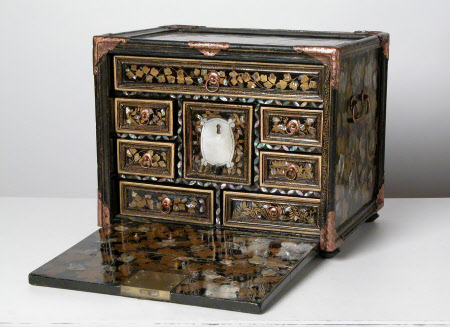Table cabinet
Category
Furniture
Date
c. 1580 - 1620
Materials
Wood (softwood) covered with black lacquer decorated with gold and mother of pearl and with copper and either brass or gilded copper mounts
Measurements
275 mm (H); 335 mm (W); 250 mm (D)
Place of origin
Japan
Order this imageCollection
Chirk Castle, Wrexham
NT 1170725
Summary
A lacquer table cabinet, Japan, c.1580–1620, rectangular, with a fall front opening to reveal a group of seven drawers around a central door, densely decorated with mother of pearl and gold on black, the outside of the fall front with a central image of a pair of deer among foliage surrounded by a border of ellipses arranged in circles (shippō-tsunagi), with copper mounts at the corners and handles at the sides and a brass or gilded copper lock plate and hinges (possibly later replacements) to the fall front, on four lozenge-shaped feet (probably added in Europe).
Full description
The shape of this type of table cabinet was derived from Portuguese and Spanish cabinets. The style of decoration, with lavish use of mother of pearl, was likewise aimed at Portuguese and Spanish merchants who were trading with the Japanese during the sixteenth century. From around 1600 this type of lacquer was also being acquired by British and Dutch merchants. This small cabinet may be associated with Sir Thomas Myddelton I (1550–1631), a founding member of the English East India Company (compare the much larger but similarly decorated namban lacquer coffer at Chirk Castle, inv. no. NT 1170737). For more examples of this type of fall-fronted cabinet, see Oliver Impey and Christiaan Jörg, Japanese Export Lacquer 1580–1850, Amsterdam, Hotei Publishing, 2005, pp.120–8. (Emile de Bruijn and Megan Wheeler, July 2024)
Provenance
Possibly acquired by Sir Thomas Myddelton I (1550–1631) and thence by descent; acquired by private treaty by the National Trust, 1994.

